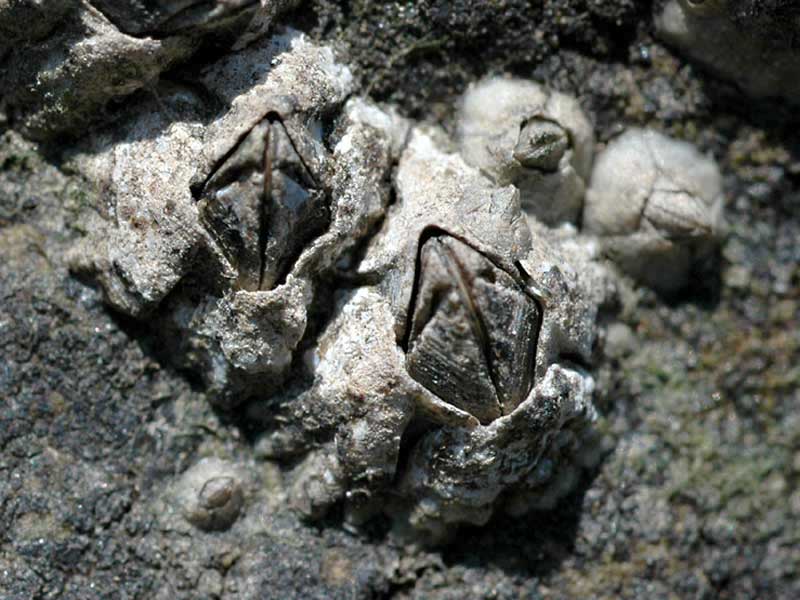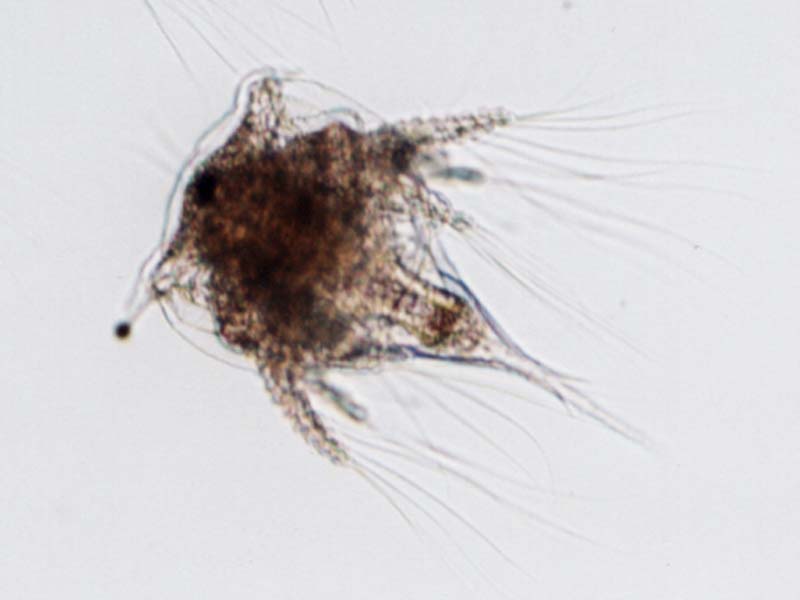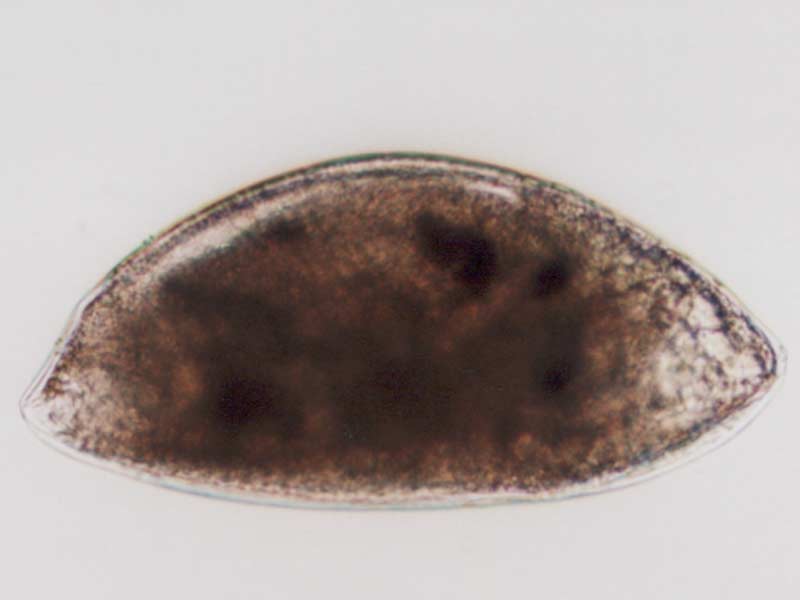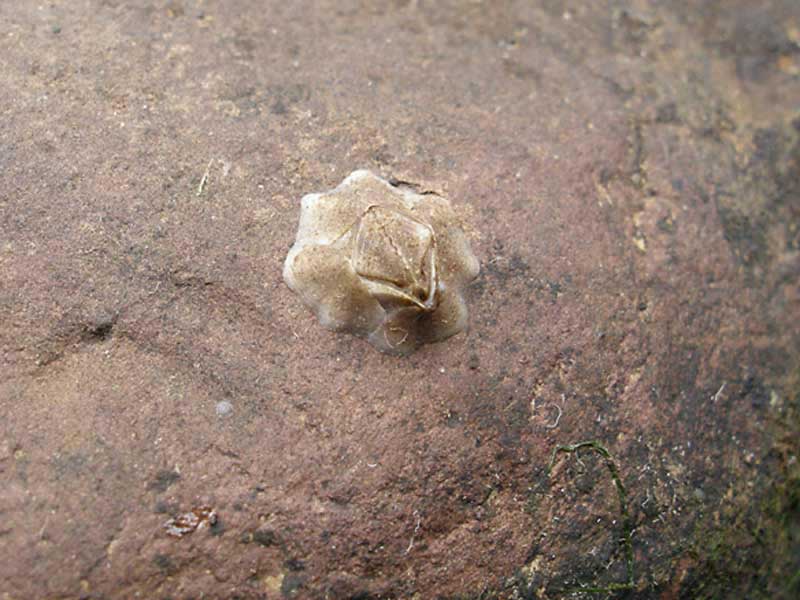Modest barnacle (Austrominius modestus)
Distribution data supplied by the Ocean Biodiversity Information System (OBIS). To interrogate UK data visit the NBN Atlas.Map Help
| Researched by | Penny Avant | Refereed by | Admin |
| Authority | (Darwin, 1854) | ||
| Other common names | New Zealand barnacle | Synonyms | Elminius modestus |
Summary
Description
Austrominius modestus is a small barnacle, 5-10 mm in diameter, characterised by having only 4 calcified shell plates. The body shape is low and conical with a large diamond shaped opercular aperture. In young barnacles the shell plates are smooth and the bottom margin of each has an indentation in the centre. The shell plates of older individuals have marked vertical ridges that give the barnacle an irregular, roughly circular margin. The young are opalescent greyish white in colour while the adults become drab greyish brown and eroded.
Recorded distribution in Britain and Ireland
Found all around the coast of England and Wales and in a few locations around the coast of Scotland and Ireland and in the Scottish Islands.Global distribution
Found on the Atlantic coasts of Europe from Germany to Gibraltar.Habitat
Elminius modestus is found at all levels of the shore but is more common mid-shore and may extend to shallow sublittoral. It attaches to a wide variety of substrata including rocks, stones, shells, other crustaceans and artificial structures including ships. It is more tolerant of turbidity and reduced salinity than Semibalanus balanoides and Chthamalus species and is found in estuaries as well as on open coasts where the wave exposure is not high.Depth range
-Identifying features
- A small barnacle, 5-10 mm in diameter.
- Body plan symmetrical with 4 calcified wall plates.
- A low conical body shape with a diamond shaped opercular aperture.
Additional information
Austrominius modestus occurs naturally in Australasia and was first reported in Britain in 1946, by which time it was already widespread in the southeast of England. The first colonization, probably by shipping, was thought to be in Southampton Water, from where it spread rapidly along the coast, reaching extensive parts of the whole British mainland by a combination of natural and artificial means (Crisp, 1958). By 1972 it was common in parts of the west coast of Scotland and in 1978 it was reported in Shetland (Hiscock et al.,1978). Austrominius modestus not only competes with endemic British species, particularly Balanus balanoides, but has colonized some sheltered and estuarine habitats not previously inhabited by them (Bassingdale, 1964).
Listed by
- none -
Bibliography
Bassindale, R., 1964. British Barnacles. London: The Linnean Society of London.[Synopses of the British Fauna, no. 14.]
Bruce, J.R., Colman, J.S. & Jones, N.S., 1963. Marine fauna of the Isle of Man. Liverpool: Liverpool University Press.
Crisp, D.J., 1958. The spread of Elminius modestus Darwin in north-west Europe. Journal of the Marine Biological Association of the United Kingdom, 37, 483-520.
Eno, N.C., Clark, R.A. & Sanderson, W.G. (ed.) 1997. Non-native marine species in British waters: a review and directory. Peterborough: Joint Nature Conservation Committee.
Fish, J.D. & Fish, S., 1996. A student's guide to the seashore. Cambridge: Cambridge University Press.
Hawkins, S. J. & Jones, H. D., 1992. Rocky Shores. London: Immel.
Hayward, P.J. & Ryland, J.S. (ed.) 1995b. Handbook of the marine fauna of North-West Europe. Oxford: Oxford University Press.
Hiscock, K., Hiscock, S. & Baker, J.M., 1978. The occurrence of the barnacle Elminius modestus in Shetland. Journal of the Marine Biological Association of the United Kingdom, 58, 627-629.
Howson, C.M. & Picton, B.E., 1997. The species directory of the marine fauna and flora of the British Isles and surrounding seas. Belfast: Ulster Museum. [Ulster Museum publication, no. 276.]
Datasets
Bristol Regional Environmental Records Centre, 2017. BRERC species records recorded over 15 years ago. Occurrence dataset: https://doi.org/10.15468/h1ln5p accessed via GBIF.org on 2018-09-25.
Bristol Regional Environmental Records Centre, 2017. BRERC species records within last 15 years. Occurrence dataset: https://doi.org/10.15468/vntgox accessed via GBIF.org on 2018-09-25.
Centre for Environmental Data and Recording, 2018. IBIS Project Data. Occurrence dataset: https://www.nmni.com/CEDaR/CEDaR-Centre-for-Environmental-Data-and-Recording.aspx accessed via NBNAtlas.org on 2018-09-25.
Centre for Environmental Data and Recording, 2018. Ulster Museum Marine Surveys of Northern Ireland Coastal Waters. Occurrence dataset https://www.nmni.com/CEDaR/CEDaR-Centre-for-Environmental-Data-and-Recording.aspx accessed via NBNAtlas.org on 2018-09-25.
Cofnod – North Wales Environmental Information Service, 2018. Records of Invasive Non Native Species held on the Cofnod database. Occurrence dataset: https://doi.org/10.15468/nxdbhu accessed via GBIF.org on 2018-09-25.
Fenwick, 2018. Aphotomarine. Occurrence dataset http://www.aphotomarine.com/index.html Accessed via NBNAtlas.org on 2018-10-01
Fife Nature Records Centre, 2018. St Andrews BioBlitz 2015. Occurrence dataset: https://doi.org/10.15468/xtrbvy accessed via GBIF.org on 2018-09-27.
Kent Wildlife Trust, 2018. Biological survey of the intertidal chalk reefs between Folkestone Warren and Kingsdown, Kent 2009-2011. Occurrence dataset: https://www.kentwildlifetrust.org.uk/ accessed via NBNAtlas.org on 2018-10-01.
Kent Wildlife Trust, 2018. Kent Wildlife Trust Shoresearch Intertidal Survey 2004 onwards. Occurrence dataset: https://www.kentwildlifetrust.org.uk/ accessed via NBNAtlas.org on 2018-10-01.
Lancashire Environment Record Network, 2018. LERN Records. Occurrence dataset: https://doi.org/10.15468/esxc9a accessed via GBIF.org on 2018-10-01.
Manx Biological Recording Partnership, 2018. Isle of Man historical wildlife records 1990 to 1994. Occurrence dataset: https://doi.org/10.15468/aru16v accessed via GBIF.org on 2018-10-01.
Merseyside BioBank., 2018. Merseyside BioBank (unverified). Occurrence dataset: https://doi.org/10.15468/iou2ld accessed via GBIF.org on 2018-10-01.
National Trust, 2017. National Trust Species Records. Occurrence dataset: https://doi.org/10.15468/opc6g1 accessed via GBIF.org on 2018-10-01.
NBN (National Biodiversity Network) Atlas. Available from: https://www.nbnatlas.org.
Norfolk Biodiversity Information Service, 2017. NBIS Records to December 2016. Occurrence dataset: https://doi.org/10.15468/jca5lo accessed via GBIF.org on 2018-10-01.
OBIS (Ocean Biodiversity Information System), 2025. Global map of species distribution using gridded data. Available from: Ocean Biogeographic Information System. www.iobis.org. Accessed: 2025-08-08
Outer Hebrides Biological Recording, 2018. Invasive Non-Native Species, Outer Hebrides. Occurrence dataset: https://doi.org/10.15468/30erdy accessed via GBIF.org on 2018-10-01.
South East Wales Biodiversity Records Centre, 2018. INNS Data: All Taxa (South East Wales). Occurrence dataset: https://doi.org/10.15468/crhjs2 accessed via GBIF.org on 2018-10-02.
South East Wales Biodiversity Records Centre, 2018. SEWBReC Myriapods, Isopods, and allied species (South East Wales). Occurrence dataset: https://doi.org/10.15468/rvxsqs accessed via GBIF.org on 2018-10-02.
South East Wales Biodiversity Records Centre, 2018. Dr Mary Gillham Archive Project. Occurance dataset: http://www.sewbrec.org.uk/ accessed via NBNAtlas.org on 2018-10-02
West Wales Biodiversity Information Centre, 2018. INNS Data: All Taxa (West Wales). Occurrence dataset: https://doi.org/10.15468/ydifzd accessed via GBIF.org on 2018-10-02.
Citation
This review can be cited as:
Last Updated: 03/07/2007








